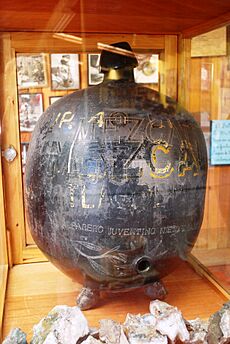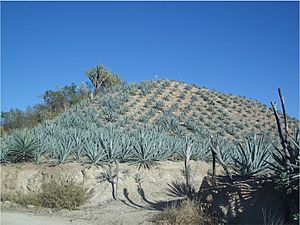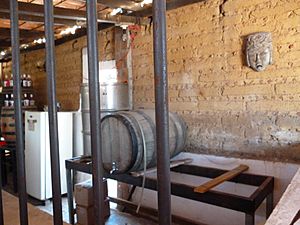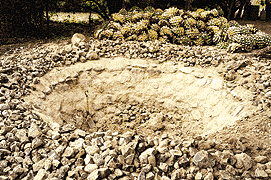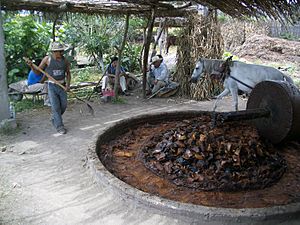Mezcal facts for kids
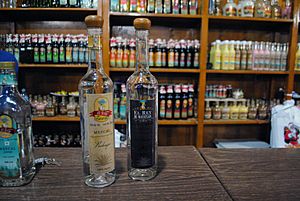
Bottles at a factory in Teotitlán del Valle, Oaxaca
|
|
| Type | Distilled beverage |
|---|---|
| Country of origin | Mexico |
| Introduced | 16th century |
| Alcohol by volume | 40–55% |
| Proof (US) | 80–110° |
| Color | Clear or golden |
| Flavor | Sweet, fruity, earthy, smoky |
| Ingredients | agave |
| Related products | tequila, bacanora, raicilla, pulque |
Mezcal is a special alcoholic drink from Mexico. It is made from the agave plant. The word mezcal comes from an old Mexican language called Nahuatl. It means "oven-cooked agave."
Agave plants grow naturally in the Americas. More than 90% of mezcal is made in the Mexican state of Oaxaca. But you can find it all over Mexico and in other countries too. Before the Spanish arrived, people in Mexico made fermented drinks from agave plants, like pulque.
Mezcal is still made in a very traditional way. The heart of the agave plant, called the piña, is cooked and then used to make the drink. People in Mexico usually drink mezcal plain. It has a strong, smoky taste. Even though it's not as famous as tequila, mezcal is becoming more popular around the world.
Contents
History of Mezcal: An Ancient Drink
The agave plant was very important in Mexico before the Spanish came. It was used in religious ceremonies and for daily life. People cooked the "piña" (heart) of the agave and fermented its juice. There's a myth about how mezcal began. It's said that lightning struck an agave plant, cooking it and releasing its juice. Because of this, mezcal is sometimes called the "elixir of the gods."
While fermented agave drinks like pulque existed long ago, the process of making mezcal by heating and collecting the vapor (distillation) came later. Historians believe the Spanish or Filipino sailors brought this method to Mexico. The Spanish learned distillation from the Moors in Spain. Filipino sailors brought their own distilling methods when they came to Mexico by ship in the 1570s.
In the early 1600s, the Spanish government in Mexico tried to stop people from making other local drinks. This was because they wanted people to buy drinks imported from Spain. This led to more people making and selling mezcal. The first time mezcal was mentioned in official records was in 1619. By 1638, the government started to control mezcal sales.
To avoid these rules, mezcal makers moved their production to hidden areas. They used wild agave plants that grew in these remote places. This helped mezcal production to continue and grow. The small size of the early distilling equipment also made it easy to hide and move. This helped mezcal survive and become popular.
Mezcal Agave: The Plant Behind the Drink
The agave plant is a special plant with almost 200 different types. The agave used for mezcal has big, thick leaves with sharp points. When the plant is ready, it forms a "piña" or heart in the middle. This is the part used to make mezcal. It takes a long time for an agave plant to grow, usually between seven and fifteen years. This depends on the type of agave and if it's grown on a farm or found in the wild. You can see many agave fields in the dry areas of Oaxaca and other parts of Mexico.
Agave Varieties Used for Mezcal
Mezcal can be made from over 30 different kinds of agave plants. This is different from tequila, which is only made from one type called blue agave. The most common agave used for mezcal is called espadín. It's the main type grown in Oaxaca.
Other important types include arroqueño, cirial, barril, mexicano, and cincoañero. One famous wild agave is tobalá. There are also others like madrecuixe, tepeztate, and jabalí. Sometimes you'll see the word silvestre on a bottle. This just means the agave was collected from the wild, not grown on a farm.
How Mezcal is Made: A Traditional Process
Mezcal is usually made by hand by small producers. Many villages have special places called fábricas or palenques where mezcal is made. They use methods that have been passed down for hundreds of years. This is different from how tequila is often made today, which is usually in large factories.
The process starts by harvesting the agave plants. Each plant can weigh about 40 kilograms (88 pounds). Workers cut off the leaves and roots to get to the piña, or heart. These piñas are then cooked for about three days. They are often cooked in special pit ovens, which are holes in the ground filled with hot rocks. This underground cooking gives mezcal its unique smoky taste.
After cooking, the piñas are crushed and mashed. This was traditionally done with a large stone wheel pulled by a horse. Then, the mashed agave is put into big vats or barrels with water. It is left there to ferment.
Once fermented, the liquid is collected and heated in clay or copper pots. This process, called distillation, helps to make the drink stronger and changes its flavor. The finished mezcal is then put into bottles. Mezcal that is not aged is called joven, meaning "young." Some mezcal is aged in wooden barrels for a few months or even several years. Mezcal can have a high alcohol content, up to 55%. Like tequila, mezcal is usually distilled twice.
Mezcal comes in many different types. The flavor depends on the agave used and what is added during fermentation. For example, a special type called de pechuga is made by distilling the mezcal with a chicken breast. Other types might have cinnamon or fruit added. But most mezcal is made without extra flavors, so you can taste the agave.
The Mezcal Worm
Sometimes, a bottle of mezcal might have a "worm" inside. This isn't really a worm, but a type of moth larva that can live on agave plants. People have different ideas about why it's added. Some say it's a marketing trick. Others say it shows the mezcal is good to drink. And some believe it adds flavor.
Mezcal Categories
Mezcal comes in different categories. There are those made from 100% agave and those mixed with other ingredients (but still at least 60% agave). Both types have four main categories:
- Joven (young): This mezcal is clear and not aged much.
- Dorado (golden): This mezcal is not aged, but caramel is added to give it a golden color. This is more common for mixed mezcals.
- Reposado (rested): This mezcal is aged in wood barrels for two to nine months.
- Añejo (aged): This mezcal is aged in barrels for at least 12 months. The best añejo mezcals are often aged for 18 months to three years. If it's 100% agave, it might be aged for about four years.
Mexico has many agave farms for mezcal, owned by thousands of producers. Millions of liters of mezcal are made each year, with over 150 different brands. The mezcal industry provides many jobs. To be officially called mezcal, the drink must come from specific areas in Mexico. Oaxaca produces most of Mexico's mezcal.
Making mezcal uses a lot of water and firewood. For example, making one liter of mezcal needs about 10 liters of water and 7 kilograms (15 pounds) of firewood. This can be a problem for the environment. Some communities are trying to control how much firewood is cut. There are also concerns about pollution from leftover plant parts and chemicals.
Mezcal Festival: A Celebration of Culture
Every year, the state of Oaxaca holds the International Mezcal Festival. It takes place in the capital city, Oaxaca de Juárez. At the festival, local people and tourists can try and buy many different kinds of mezcal made in the state. Mezcals from other states also join the festival. This festival started in 1997 and happens at the same time as the yearly Guelaguetza festival. In 2009, over 50,000 people visited the festival.
See also
 In Spanish: Mezcal para niños
In Spanish: Mezcal para niños
- Cocuy
- Kahlúa
- Mexican beer
- Mexican cuisine
- Mexican wine
- Miske
- Santiago Matatlán
- Sotol
- Tequila
- Tiswin


